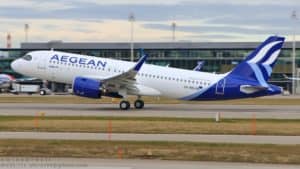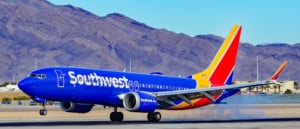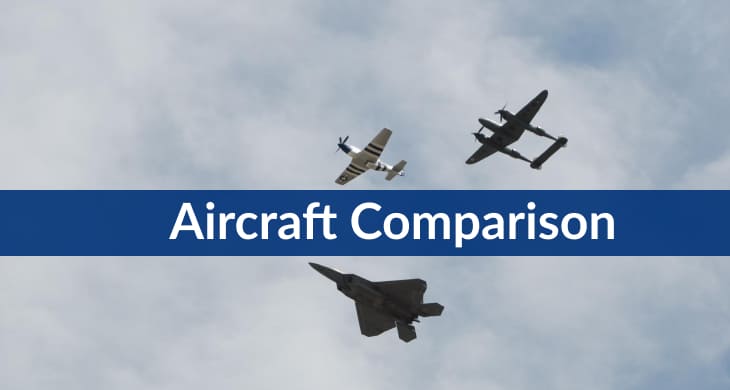When it comes to commercial airliners, there are two main players in the market: Airbus and Boeing. Both companies have a wide range of models that cover everything from small regional jets to long-haul jumbo jets.
In this article, we will compare the A320 and 737, two of the most popular models from Airbus and Boeing. We will look at the features and specifications of each aircraft, and see which one comes out on top!
| Aircraft: | Airbus A320neo | Boeing 737 MAX 8 |
|---|---|---|
| Photo: |
 |
 |
| Country: | France | United States |
| Manufactured: | from: 2014 to: Present | from: 2014 to: 2020 |
| ICAO: | A20N | B38M |
| Price: | $110 million | $121.6 million |
| Avionics: | - | Collins Aerospace |
| Engine: | 2x Pratt & Whitney PurePower PW1100G-JM / CFM International’s LEAP-1A | 2x CFM International LEAP-1B |
| Engine Type: | Turbofan | Turbofan |
| Power: | 27,120 pound-force | 29,317 pound-force |
| Max Cruise Speed: |
473 knots 876 Km/h |
453 knots 839 Km/h |
| Approach Speed (Vref): | - | - |
| Travel Range: |
3,400 Nautical Miles
6,297 Kilometers |
3,550 Nautical Miles
6,575 Kilometers |
| Fuel Economy: | - | - |
| Service Ceiling: | 39,800 feet | 41,000 feet |
| Rate of Climb: | - | - |
| Take Off Distance: |
1951 metre 6,400.84 feet |
2500 metre 8,202.00 feet |
| Landing Distance: | - |
1500 metre 4,921.20 feet |
| Max Take Off Weight: |
79,015 Kg 174,196 lbs |
82,191 Kg 181,198 lbs |
| Max Landing Weight: |
67,400 Kg 148,590 lbs |
69,309 Kg 152,799 lbs |
| Max Payload: |
20,000 Kg 44,092 lbs |
20,882 Kg 46,036 lbs |
| Fuel Tank Capacity: |
7,060 gallon 26,725 litre |
6,820 gallon 25,816 litre |
| Baggage Volume: |
37 m3 1,307 ft3 |
- |
| Seats - Economy: | 194 seats | 210 seats |
| Seats - Business Class: | - | - |
| Seats - First Class: | - | - |
| Cabin Height: | - |
4.01 metre 13.16 feet |
| Cabin Width: |
3.7 metre 12.14 feet |
3.53 metre 11.58 feet |
| Cabin Length: |
27.51 metre 90.25 feet |
39.12 metre 128.34 feet |
| Exterior Length: |
37.57 metre 123.26 feet |
39.52 metre 129.66 feet |
| Tail Height: | 11.76 metre - 38.58 feet | - |
| Fuselage Diameter: |
3.95 metre 12.96 feet |
- |
| Wing Span / Rotor Diameter: |
35.80 metre 117.45 feet |
35.9 metre 117.78 feet |
| Wing Tips: | No Winglets | Split Scimitar Winglet |
| More Info: | Airbus A320neo | Boeing 737 MAX 8 |
|
Data presented is for entertainment purposes and should not be used operationally.
|
Other Airbus A320neo comparisons:
Other Boeing 737 MAX 8 comparisons:
Airbus the A320
The Airbus A320 is a twin-engine, single-aisle plane that can carry up to 180 passengers. It is frequently used for short and medium-haul flights.
One of the main features of the A-320 is its fly-by-wire system, which allows the pilot to control the plane using electronic signals instead of hydraulic systems. This makes the A-320 more fuel efficient and reduces maintenance costs.
The A-320 also has a two-wheel nose landing gear, which helps to reduce wear and tear on the tires. Additionally, the A-320 is equipped with side stick controls, which give the pilot more precise control over the plane.
Finally, the A-320 has an emergency exit window in the cockpit, which can be used in case of an emergency.
Why was the Airbus A320 developed?
The Airbus A-320 was developed in the 1980s as a response to the increasing demand for fuel-efficient commercial aircraft.
The aircraft was designed to be lighter and more aerodynamic than previous models, and it was equipped with new engines that promised to reduce fuel consumption. In addition, the A-320 featured an advanced flight control system that made it easier to fly and land.
As a result of these innovations, the A-320 quickly became one of the most popular commercial aircraft, and it remains in production today.
Read More On:
What purpose does the Airbus A320 serve?
The Airbus A-320 is a versatile aircraft that can be used for a variety of purposes. It is commonly used as a passenger airliner, but it can also be configured to transport cargo or to serve as a medical evacuation plane.
The A-320 is one of the most popular planes in the Airbus fleet, and it has a reputation for being reliable and efficient. The A-320 is often used on short-haul routes, but it is also capable of flying long distances.
With a range of nearly 4,000 miles, the A-320 can easily connect major cities around the world.
Boeing 737
The Boeing 737 is a narrow-body aircraft produced by Boeing Commercial Airplanes. Introduced in 1967, it was the first aircraft designed specifically for short-haul flights and has become one of the most popular planes in the skies.
More than 10,000 737s have been built, and the aircraft is used by airlines around the world. The 737 is available in a variety of models, each tailored to meet the needs of a particular airline.
For example, the 737-700 is a short-range model typically used for domestic flights, while the 737-900ER is a long-range model with increased fuel capacity and extended range.
No matter which model an airline chooses, the 737 provides passengers with a comfortable, reliable ride.
B737 modern variants:
Why was the Boeing 737 developed?
The 737 was originally developed as a shorter, more fuel-efficient alternative to the 707 and 727 models. It seats up to 189 passengers and has a range of 3,700 nautical miles. The 737 has undergone several redesigns over the years, most notably the NG (Next Generation) series, which entered service in 1993.
The latest version of the 737, the MAX, made its maiden flight in 2016 and began commercial service in 2017. To date, Boeing has received orders for over 5,000 MAX aircraft from airlines around the world.
What purpose does the Boeing 737 serve?
The Boeing 737 is a twin-engine, short-to-medium-range airplane. Its primary use is as a passenger airliner, though it has also been used as a cargo plane and in other roles. The first 737 was introduced in 1967 and quickly became one of the most popular airplanes in the world.
Over time, various modifications and upgrades have been made to the 737, but its basic design remains largely unchanged.
Today, there are over 10,000 737s in operation around the world, making it one of the most ubiquitous airplane models in existence.
Similarities Between the Airbus A320 & Boeing 737
The Airbus A-320 and Boeing 737 are two of the most popular aircraft in the world. While they share some similarities, there are also some significant differences between the two planes.
Both the A-320 and 737 are single-aisle, twin-engine aircraft that seat between 150 and 200 passengers. They both have a range of approximately 3,000 miles and a cruising speed of around 600 miles per hour.
Both planes also use similar technology, including fly-by-wire controls and digital cockpits.
Differences Between the Airbus A320 & Boeing 737
There are many differences between the Airbus A-320 and the Boeing 737. The A-320 is a newer model, while the 737 has been around for longer. As a result, the A-320 is more fuel efficient and has more advanced features. For example, it uses LED lighting instead of traditional incandescent bulbs, and its engines are more fuel efficient.
In addition, the A-320 has a larger flight deck, which gives pilots better visibility during takeoff and landing. However, the 737 is still a popular choice for many airlines because it can fly farther on a single tank of fuel.
It also has a larger cargo capacity, which is important for airlines that transport large quantities of goods. In addition, the 737 can take off and land on shorter runways than the A-320. As a result, it can serve smaller airports that don’t have long runway lengths.
Airbus A320: The Better
The Airbus A-320 is a popular choice for airlines around the world because of its fuel efficiency, reliability, and comfortable cabin. The A-320 has a longer range than the Boeing 737 and can seat more passengers, making it a popular choice for long-haul flights.
The A-320’s engines are also more fuel efficient, and the plane has a lower operating cost than the 737.
Additionally, the A-320’s airframe is made of lightweight composite materials, which makes the plane lighter and more fuel efficient.
The A-320 also has a more advanced fly-by-wire control system than the 737, which provides pilots with greater control over the plane.
Boeing 737: The Better
The Boeing 737 and Airbus A320 are two of the most popular medium-haul aircraft in operation today. Both planes are widely used by major airlines around the world, and both offer similar levels of comfort and amenities.
However, there are a few key factors that make the Boeing 737 a better airplane than the Airbus A320.
First, the 737 is more fuel-efficient thanks to its newer engine design. This translates into significant savings for airlines over the lifetime of the plane. Second, the 737 has a wider body than the A320, which provides more space for passengers and luggage.
Finally, the 737 is equipped with larger windows, which offer passengers a better view of the world outside.
Conclusion: A320 vs 737
When it comes to choosing between the A-320 and 737, both planes have their advantages and disadvantages. The A-320 is a newer model and has more advanced features, making it more fuel efficient and reliable.
However, the 737 has a larger cargo capacity, can take off from shorter runways, and has a wider cabin that provides more space for passengers.
Ultimately, the choice between the A-320 and the 737 depends on the individual needs of an airline. Both planes are excellent choices for medium-haul flights, but each has its advantages that must be taken into consideration when making a decision.


